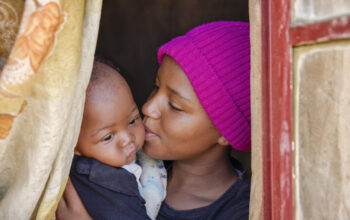What’s the score? Universal health coverage goals discussed in New York
The headlines were about North Korea, warmongering, sanctions and, well, diplomacy. But this year’s UN General Assembly in New York in truth devoted far more time to sustainable development, climate change, mass migration and poverty – and how to provide universal health care (UHC), including for the 400 million who lack access to essential services such as immunization, family planning and even basic hospital care.
Ministers and their officials discussed, publicly and in private, urgent ways to achieve the Sustainable Development Goals (SDGs) and in particular goal 3.8 that focuses on delivering Universal Health Coverage – “financial risk protection, access to quality essential healthcare services, and access to safe, effective, quality and affordable essential medicines and vaccines for all”.
To move closer to reaching this goal, public/private partnerships are needed which is why at General Assembly there were multiple side events where officials from governments, international agencies, and non-state actors discussed new, innovative and affordable ways to strengthen health systems and fund healthcare for all.
So, while the great and good were deliberating UHC in New York, it was striking that the New York Times (NYT) ran an amusing but also educational article on choosing the best healthcare system in the world. The authors ran a mini global Champions League tournament to find the health winner among eight successful economies: Australia, Canada, Britain, France, Germany, Singapore, the USA and Switzerland. The eventual champion, chosen by five experts, was…Switzerland (where, as it happens, premiums charged by health insurance funds are to go up as they do each year, prompting many Swiss to criticise our healthcare system as the world’s most expensive – a view incidentally not substantiated by the facts and countered by a preference for quality and access over cost containment when it comes to the crunch in national referenda).
Amusing yes but what the NYT piece underlined was the entirely different models of healthcare funding there are available. These range from the single-payer systems of Canada or Great Britain via the mix of clashing ideas in the US and Singapore to the diverse insurance-based models found in France, Germany, Switzerland and Australia. And this is critical: there is no one-size-fits-all model of UHC.
Take the extremes of the US and Singapore: health spending is 17.2 per cent of GDP in the former (where 28 million have no health insurance at all) and 4.9 per cent in the latter (which is said to provide decent care albeit it is said that access and quality vary depending on where you stand on the socioeconomic ladder). In fact, the band of health spending in industrialised countries is not that wide: 9 per cent of GDP in Australia, just over 10 per cent in the UK and just under 12 per cent in France. For the record, it’s 11.66 per cent in Switzerland (2014).
Funding good health outcomes
Far more important to the experts than total costs was/is the ratio between costs and access to new therapies and the quality and success of treatments on offer (outcomes). Though the NYT whimsically refused to give a ranking order, preferring several play-off rounds, the Swiss won (in a tense final v France) because it has superior outcomes – and in the view of the NYT experts provides a working and more effective model for Barack Obama’s Affordable Care Act (that his successor has so far failed to abolish). The experts also paid tribute to the Swiss system of mandatory basic health insurance combined with a broad choice of insurance provider. The Americans, of course, value the innovation dynamic of their health system that, at its peak, produces outcomes of an extraordinary quality but remains virtually closed to millions.
What matters here is that each country can and does find its own solutions to funding a decent health service as Switzerland has – and not necessarily adopt the Swiss model. Returning to the UN debate, reaching UHC is first and foremost a political choice for individual governments, and the WHO itself has concluded that 85 per cent of the funding gap to reach it could be met by countries themselves, albeit 32 of the poorest countries will still require aid.
As GAVI’s Seth Berkley and WHO DG Dr. Tedros have said, if countries have limited financial resources and human capital they should focus on the most cost-effective solutions, especially those that most benefit the poor – what they call “progressive universalism”. But there is no single path to pursue this nor a single model of funding a health service in the end: faced with, say, different arrays of chronic diseases countries will make their own (tough) choices. But what they’ll be doing is revolutionising primary health care on their own patch in their own ‘new deal for health’.
#Health4All
Private sector actors such as Philips as well as our own trade body and international agencies such as the IFRC and Unicef can and will play a supportive role in improving UHC and access as evidenced through the current Devex Healthy Horizons campaign that empowers local people to seize initiatives.
Research-based pharma companies can make a difference within this revitalised global partnership. On the way to reaching the critical SDGs such as UHC there are three key ways they can help: introducing and scaling up proven access models in new locations and for new diseases; establishing a community of practice joining all efforts to harness science, technology and business for enhanced innovation; and implementing an independent, transparent and evidence-based monitoring and accountability framework to ensure that all sectors work collaboratively across the components of access to medicine.
Pharmaceutical companies train healthcare workers, help create health information systems, help raise diseases awareness, transfer technology, improve point-of-care service delivery and invest in health infrastructure. To pick just a couple of examples, Merck & Co helps with the $500m 10-year MSD for Mothers program to reduce maternal mortality in 30 countries, AstraZeneca is active in Kenya and Ethiopia with a sustainable chronic care model for tackling hypertension and cardiovascular disease, Pfizer is tackling trachoma, and Novartis works with WHO to eliminate leprosy. A whole range of firms develop and offer their R&D in the fight against disease locally.
What matters above all is that we should have an informed and open debate on how best to reach UHC. After all, Switzerland may have the best health service in the world but no Swiss team has ever won the Champions League.
Author






